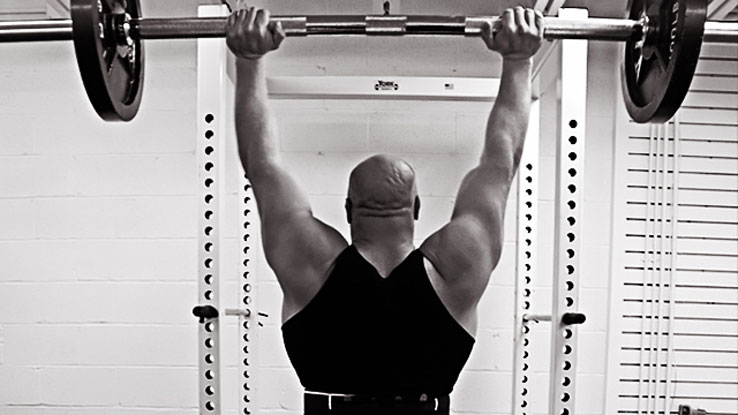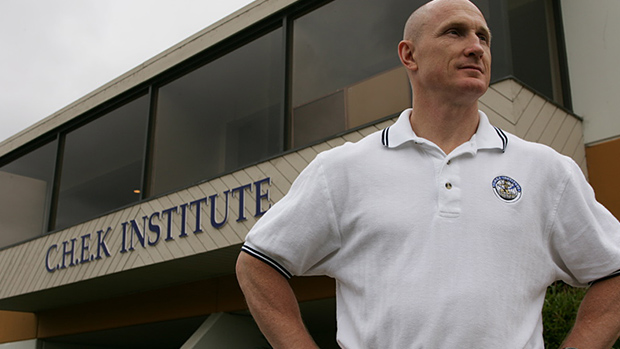Here's what you need to know...
- Superset a compression exercise with a decompression exercise. They complement one another instead of placing your spine under excessive stress.
- Superset a strength exercise with a metabolic exercise. Do strength work alongside metabolically taxing work to build muscle.
- Superset strength work with an exercise that stretches your muscles. Stretching a muscle under load will increase hypertrophy and orthopedic health.
- Post activation potentiation (PAP) will activate back muscles. Turn on your back muscles and wake up your nervous system with PAP.
For some lifters, the back is a stubborn bitch that just won't grow or get stronger. These four strategies will show your back who's boss.
Supersets should be strategic. Like most schemes in the strength game, there's a reason behind the combined movements. The bigger and more compound the movements are, the more room for error in the way they synergize together.
One of the problems with many supersets is the compression that the spinal column is forced into on two paired movements with minimal rest or recovery. This adds double the compression to the spine and places it under challenging loads for extended periods of time.
Spinal stabilizing musculature was designed to create tension and stability through the pillar and be highly reactionary to the slightest deviations away from a neutral alignment and positioning. The more force is exerted through the spine that requires it to be stable, the more chance of losing the neutral position and essentially putting yourself at risk for an injury.
If you're supersetting a movement that compresses the spine, like a barbell back squat, the paired movement should allow spinal decompression, like a pull-up. Matching these two types of movements together will do a world of good for your spinal health. Place the compressive movement before your decompression based movement. For back emphasis training days, a great superset is a deadlift variation with a vertical pull.
Rack Pull / Chin-Up Superset
The rack pull is considered a spinal compressive movement and the chin-up a decompression movement. If you go heavy and create as much tension as possible through your lats and back on the dead, the pull-ups should really become challenging quickly.
Two of the biggest players in strength and growth are heavy loading which creates maximal mechanical tension and higher rep movements that cause metabolic stress. By programming a strength-based movement before a more metabolically targeted movement, you get the best of both worlds.
The key here is to keep your training loads as high as possible while still executing your sets with form that won't get you hurt or laughed at. Follow this movement up with a higher rep or higher tension-based movement and you'll create a very dynamic stress environment to elicit a cascade of growth factors.
When choosing a metabolic stress-based movement for the back, prioritize the total time under tension. Increase the reps of each set with a steady tempo, or manipulate a tempo in the eccentric (negative) or isometric portion of the movement that will involve fewer reps per set.
I like the seated low-cable row with a wider neutral grip. This movement provides the perfect range of motion, a great amount of power and tension, and doesn't leave me with jacked up shoulders after a heavy training day. Find your feel-good movements so that you can load them with more confidence. Place your emphasis on performance, not fighting the movement pattern.
Low Cable Row / Single-Arm Lat Pulldown Superset
This movement is programmed in a strength scheme. The video shows the row paired with a seated single-arm lat pulldown to create strength and metabolic stress based superset.
The single-arm lat pulldown isolates one side at a time, which increases the activation instantly. Also, increasing tension at the bottom of each rep by squeezing the lat as hard as possible really increases the total tension of the set, making this a metabolic-based movement.
After the first round through this superset, make sure you have close to full recovery, as the leading movement is strength based. You don't want to sacrifice heavy loading or reps for the sake of cumulative stress, so keep that in mind and recover between sets.
The thing about hypertrophy training is that novelty is important for growth. That said, strength and metabolic based movements can also be paired together in the opposite order. Here's an example.
Single-Arm Barbell Row / Landmine Row
The single-arm barbell row involves an isolation of one arm at a time, but also an accentuated range of motion with a stretch at the bottom of each rep to increase the total tension. The paired movement, the landmine row, is programmed in a pure strength scheme and more normalized range of motion and tempo.
Try the combination of a primary strength-based movement for the back paired with a stretch-based exercise. This combo is one of the very best bang-for-your-buck supersets for increasing strength and muscle mass while also maintaining and even enhancing mobility through the shoulders and back.
As anyone who's tried to stretch a fully pumped muscle knows, this is not a comfortable feeling. That said, this superset isn't for beginners, or even for advanced lifters that can't take an excruciating stretch for a few seconds. It's a strength exercise and an exercise that involves a larger range of motion with an end-range stretch. A great choice is the neutral-grip lat pulldown with a slow eccentric and forced stretching.
Accentuated Eccentric Neutral Grip Lat Pulldown
The neutral grip allows the lats to increase their range of motion into a stretch at the top of the movement while also helping the shoulder complex stay in a more relatively centrated position. Both variables are great for longevity, orthopedic health, and muscularity.
Rock back a little in this exercise to create almost a high-row angle on the concentric (lifting) portion of the lift, then come back and normalize your torso position into neutral. Bring your head forward to really stretch through the eccentric (lowering) portion of the lift.
If you master this movement, feel free to get a partner to force the eccentric by pressing down on the weight stack as you slowly let your hands and arms move up into a straightened position. (See video above.) If you're a sick bastard who loves the pain, add a 10-30 second forced stretch out of this exact position while maintaining neutral shoulder alignment and stretching through the lats, not crunching your shoulder joint.
This will stick a fork in your workout, so program it on the tail-end of an upper body or back-emphasized training day.
Post activation potentiation (PAP) techniques work well for intermediate and advanced lifters. By combining a few reps of explosive velocity-dependent movements before heavy strength or hypertrophy sets, your central nervous system (CNS) gets ramped up and ready to rock. This activation creates the ability to produce greater amounts of force at quicker rates, thus increasing the intensity and global muscular output of your working sets.
PAP needs to match the primary muscular actions to make this technique work best. For the most part, the upper back and scapular stabilizers are considered postural tonic muscles, meaning that their primary actions are more stability oriented as compared to a more phasic and dynamic set of musculature. This means that to stimulate CNS based recruitment patterns of the back from a PAP type movement, tension should be the primary component of the exercise of choice.
One of the best tactics to stimulate the back is through tension-based movements of the lats in conjunction with the scapular retractors and downward rotators. With your arms down at your sides positioned with slight internal rotation in a concentrically contracted state, the lats are able to produce loads of force. This force is largely internally directed, meaning that the external load placed on the musculature is less important than your volitional activation. You can do this method many ways, but one of my favorites is the straight-arm pulldown exercise.
The Straight Arm Pulldown
Using either a cable machine or band, creating isolated tension through the posterior chain and maximizing a isometric contraction at the bottom of each rep is a great way to stimulate these muscles and create a PAP effect.
Stick with 6-10 reps with a load that you can create maximal amount of tension with. Remember, that doesn't mean go heavy. There's a huge difference between the feel and activation of a muscle, and moving a load through space. You want to get the feel and tension, so play with your loading and get it right.
Place this exercise directly in front of any big compound back exercise such as rows, pulldowns or deadlifts with minimal rest to create the perfect environment for trainability and targeting muscles that are notoriously stubborn.





